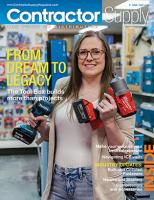Exclusive: The Three Most Pressing Questions Facing STAFDA Sales Professionals
Proven strategies for selling value over price, gaining more sales meetings and winning customers for your company.
 |
| Paul Reilly is co-author of Value-Added Selling fourth edition (McGraw-Hill 2018) and the go-to sales consultant for STAFDA. |
What is the one sales question continuously racing through your mind?
Salespeople constantly have questions running through their minds. “How do I deal with unresponsive customers?”; “Why does this one customer always focus on price?”; “Why do they keep buying from that competitor?” Our list of questions outpaces the list of answers.
This year, Tom Reilly Training partnered with STAFDA to conduct five regional sales training seminars. At the beginning of each session participants were asked, “What burning sales question do you want answered by the end of this training?” You can imagine the myriad of questions we received. We’ve summarized and grouped these questions into three categories. In rank order, here were the most common questions…along with some answers.
How do I sell value over price?
Forty-three percent of participants responded with some variation of this question. For example, “How do I sell my value?”; “How can I sell at prices higher than competitors?” and, “How do I protect margin when customers focus on price?”
Selling value continues to be the greatest challenge facing salespeople. Here are three tips to help you sell value over price.
Tip #1: Change the conversation from price to cost
Cost is a better conversation than price. Price is tangible and straightforward. Cost is broader because it focuses on what the buyer sacrifices. By expanding the conversation to cost, you can explain all the ways you help save customer on total cost.
Here are several total-cost examples: logistical cost, inventory cost, engineering cost, installation cost, delivery cost, maintenance cost, ordering cost. Identify all the ways you help reduce total cost on a project, then change the conversation from price to cost.
Tip #2: Enlarge the conversation beyond price
Buyers take mental shortcuts to simplify decision making. That’s one reason buyers focus on price. Price is easy to grasp. Value can be more abstract. Buyers also oversimplify their needs. With simple needs, any solution will work. Make the buyer aware of the complexity of their needs. Buyers are more open to your ideas if they understand the complexity of their needs. Therefore, ask questions that reveal these complex needs. For example, “What are your biggest concerns on this project?”, or, “Beyond product, what do you need from us on this project?”
Tip #3: Stretch the buyer’s time horizon
Value is long term. Price is short term. We are hard-wired to go for short-term gain over long-term gain. Therefore, buyers place more emphasis on short-term price savings vs. long-term cost savings. By transporting buyers to the future, you take the focus off of price.
Stretch the buyer’s time horizon by asking long-term questions. For example, “Long term, Mr. Buyer, what’s important to you as you make this decision?”, or, “What are your long-term cost considerations?”, or, “Walk me through this project and detail the value-added services that are important to you.” Each question stretches the buyer’s time horizon into the future.
How do I get buyers to meet with me?
Twenty percent of participants responded with some variation of this question. For example, “How can I get prospects to meet with me?”; “How can I get prospects to respond to my emails or voicemails?” and, “How do I ‘get in the door’ and meet with more prospects?” This has recently become a greater challenge for salespeople.
Decision makers are busy. In sales, you’re not only competing with other suppliers, you’re competing with everyone who needs that decision maker’s time. Your message must stand out from the crowd.
GET to the point when communicating your message. GET is an acronym for Grab their attention, Establish the need, and Tease the customer with a benefit. These three elements work across a variety of communication channels. The format can be used in emails, voice mails, sales letters, or even face-to-face meetings.
Grab their attention
Goldfish have an attention span of just nine seconds. Humans have an attention span of eight seconds. Goldfish have a longer attention span than humans! Your message better be compelling and short!
The most compelling way to grab a buyer’s attention is a referral. A referral gives you instant credibility. Using a referral symbolizes to the buyer that you created enough value that the person was willing to put their name next to yours.
You can also Grab the buyer’s attention through a trigger event. A trigger event is any event that would cause the buyer to be more open to your solution or idea. For example, the buyer was recently awarded a project, lost a project, or had change in staff.
Establish the need
Answer these questions to help you Establish the need for your solution:
- Why should the buyer hear your message?
- What is the compelling need for your solution?
- Why is there a need now?
You are attempting to connect the buyer’s needs to your opening statement. The stronger the overlap between their needs and your perceived ability to satisfy these needs, the more likely the buyer is to meet with you.
Tease the buyer
In advertising, teasers are a series of smaller ad campaigns that stimulate demand and excite the consumer. Teasing a buyer with a benefit statement is a powerful way to excite the buyer to take action—like agreeing to meet with you.
Tease the buyer by emphasizing what he gains from experiencing your solution. You are providing the buyer with a general value proposition. The more relevant the gain, the more likely the buyer is to meet with you.
How do I displace a competing supplier at an account?
Eleven percent of participants responded with some variation of this question. For example, “How can I show our value if they’re already happy with another vendor?”; “How can I prove myself when they only buy from our competition?” and, “How do you win an opportunity that is being serviced well?”
People change when the gain or pain is too great to ignore. However, there is a constant tug-of-war between those pains or gains and the status quo. Buyers ask themselves, “Is it really worth changing?”
The pain of missing out compels people to act. In Value-Added Selling, we call this opportunity value. Answer these questions for the buyer, “What do you give the buyer the opportunity to do tomorrow, that they cannot do today?”, or, “What opportunities will the buyer miss by doing nothing?” These questions tap into the loss/pain motivation of the buyer. The more motivated the buyer the more likely they are to change.
Salespeople face dynamic yet constant challenges. In our ever-changing business world, the one constant is value. Buyers want value. Your primary focus is to understand how each decision maker defines value. These techniques will help you gain an in-depth understanding of their definition. As long as buyers want value, there will be a need for sales professionals who add and create value. CS
Paul Reilly is co-author of Value-Added Selling fourth edition (McGraw-Hill 2018) and the go-to sales consultant for STAFDA. Reilly specializes in training sales professionals, sales managers, and service professionals. Tom Reilly Training offers public seminars, in-house sales training programs, and hiring and training assessments. For additional information on our training programs, call 636-778-0175 or email Paul@ReillySalesTraining.com. Visit www.TomReillyTraining.com and signup for his free newsletter.
















